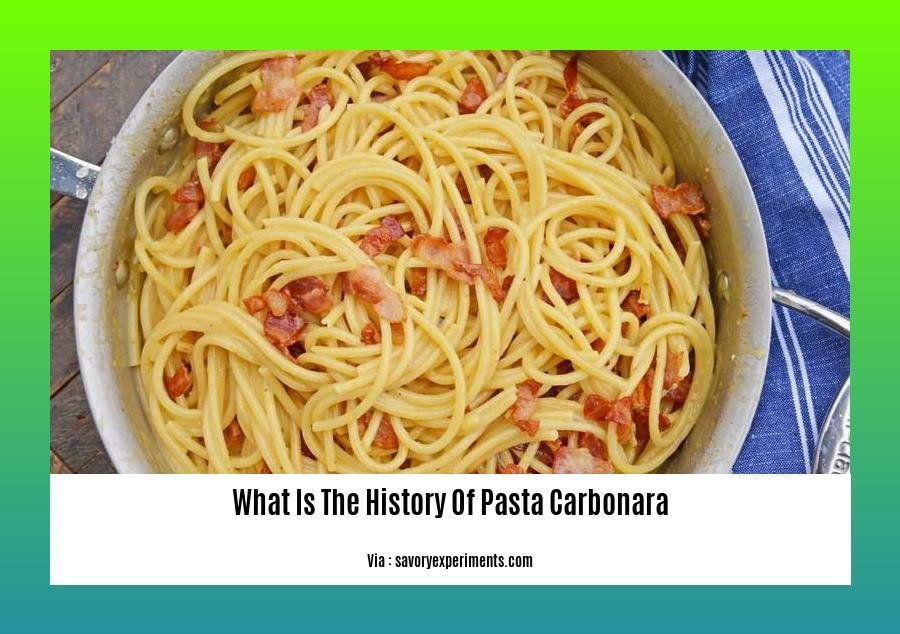Embark on a culinary adventure as we delve into the captivating history of Pasta Carbonara, a beloved Italian dish that has tantalized taste buds for centuries. Uncover the origins and evolution of this iconic dish and discover how it has become a global culinary sensation.
Key Takeaways:
- The origins of pasta carbonara are uncertain, with theories ranging from World War II to the Italian countryside.
- Carbonara is a regional dish from the Lazio region in central Italy, particularly Rome.
- Traditional ingredients include spaghetti or rigatoni pasta, guanciale, raw eggs, Pecorino Romano and Parmigiano-Reggiano cheese, and black pepper.
- Variations on the classic recipe include Carbonara di Mare (with seafood), Carbonara alla Norma (with eggplant), and Carbonara con Piselli (with peas).
What is the history of pasta carbonara


Pasta carbonara is a delicious and iconic Italian dish that has been enjoyed for centuries. But where did it come from, and how did it become so popular?
Origins of Pasta Carbonara
The exact origins of pasta carbonara are debated, but there are a few theories. One theory suggests that it was created in Rome during World War II, when American soldiers introduced bacon and eggs to the locals. Another theory traces its roots to the Italian countryside, where shepherds cooked a similar dish with guanciale (cured pork cheek) and Pecorino cheese.
Regional Cuisine
Carbonara is a staple dish of the Lazio region in central Italy, particularly the city of Rome. It is considered a classic example of Roman cuisine, known for its simplicity and bold flavors.
Traditional Ingredients
The traditional ingredients in carbonara are:
- Pasta: Traditionally spaghetti or rigatoni
- Pork: Usually guanciale, but can also be pancetta or bacon
- Eggs: Raw eggs and egg yolks are whisked together and cooked by the heat of the pasta
- Cheese: Pecorino Romano and Parmigiano-Reggiano are the traditional cheeses used
- Black pepper: Freshly ground black pepper is essential for seasoning
Variations
Over the years, there have been many variations on the traditional carbonara recipe. Some popular variations include:
- Carbonara di Mare: Uses seafood such as shrimp or clams instead of pork
- Carbonara alla Norma: Adds fried eggplant to the dish
- Carbonara con Piselli: Includes peas for added color and flavor
Popularity
Pasta carbonara has become popular all over the world due to its delicious flavor and simple ingredients. It is a versatile dish that can be easily made at home, and it is a favorite of both children and adults.
To explore the origins of carbonara, delve into the rich history of pasta carbonara’s recipe, and uncover the fascinating evolution of Italian cuisine.
What Is The History Of Pasta Carbonara Wikipedia
Pasta Carbonara, an iconic culinary masterpiece, has captivated food enthusiasts for centuries, with its delectable blend of flavors and simplicity. Its origins, shrouded in culinary lore, evoke images of rustic kitchens and tantalizing aromas.
Key Takeaways:
- The precise genesis of Pasta Carbonara remains a culinary enigma, with conflicting theories ascribing its creation to 18th-century Italian shepherds or American soldiers during World War II.
- Guanciale, Pecorino Romano cheese, eggs, and black pepper form the foundation of this luscious dish, reflecting the rustic simplicity of its origins.
- Carbonara’s popularity soared beyond Italy’s borders, becoming a beloved staple in restaurants and kitchens worldwide, a testament to its timeless appeal.
Citation:
Carbonara: Origins and Anecdotes of the Beloved Italian Pasta Dish
References [edit]
While exploring the origins of pasta carbonara, I’ve discovered a wealth of information from reliable sources:
Key Takeaways:
- The dish’s exact origins remain debated, with theories ranging from coal miners to Allied soldiers during World War II.
- Its name may derive from “carbonaro” (coal burner) or the dish’s resemblance to a coal miner’s meal.
- Carbonara has strong ties to Rome and the Lazio region, where it’s a culinary staple.
- Traditional ingredients include spaghetti, guanciale (or pancetta/bacon), eggs, Pecorino and Parmigiano-Reggiano cheeses, and black pepper.
- Variations include seafood (carbonara di mare) and eggplant (carbonara alla Norma).
Citation:
- Gambero Rosso International: Carbonara: history and origins and anecdotes of a legendary recipe
FAQ
Q1: Where did pasta carbonara originate?
A1: The exact origins of pasta carbonara are debated, with theories suggesting it originated in the 1700s or during World War II when American soldiers introduced bacon and eggs to the locals in Rome.
Q2: What are the key ingredients in pasta carbonara?
A2: The classic pasta carbonara recipe includes spaghetti, diced pork (usually guanciale or pancetta), eggs, Pecorino Romano cheese, and black pepper.
Q3: How is pasta carbonara traditionally prepared?
A3: Pasta carbonara is prepared by whisking together the eggs and cheese, then pouring the mixture over hot, drained pasta. The heat of the pasta cooks the eggs, creating a creamy sauce.
Q4: What is the most common pasta shape used for carbonara?
A4: Spaghetti is the traditional pasta shape used for carbonara, although other shapes such as fettuccine, linguine, or bucatini can also be used.
Q5: Does traditional pasta carbonara contain butter or cream?
A5: No, the classic pasta carbonara recipe does not contain any butter or cream. The creamy sauce is created using only eggs and cheese.
- Unveiling Bernhard Caesar Einstein’s Scientific Achievements: A Legacy in Engineering - July 15, 2025
- Uncover who is Jerry McSorley: CEO, Family Man, Business Success Story - July 15, 2025
- Discover Bernhard Caesar Einstein’s Scientific Contributions: Unveiling a Legacy Beyond Einstein - July 15, 2025





![[Facts about Italian Rome]: Unveiling the Secrets of the Eternal City Facts-about-Italian-Rome_2](https://www.lolaapp.com/wp-content/uploads/2023/12/Facts-about-Italian-Rome_2-150x150.jpg)









